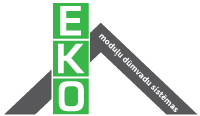- The effective height of the flue measured from connection T-piece to upper outlet shall be:
- for boilers run by gas at least 4 m.
- for boilers run by liquid or solid fuel at least 5 m.
- It is recommended for flues installed outside the building to make them thermoisolated and connect with exterior wall by use of yokes anchored in the wall (Fig.1). Minimal number of yokes – 2 pcs.; maximal distance between yokes – 3m.

- Height of flue above the roof shall meet following conditions:
-
- if roof is flat with slope up to 12°, outlet of flue shall be at least by 0,6 m higher than ridge regardless of construction of roof – Fig.2.a

- if roofs are slanting with slope of the roof above 12° and with flammable surface, outlet of the flue shall be at least by 0,6 m higher than level of ridge – Fig.2.b

- if roofs are slanting with slope of the roof above 12° and with incombustible, difficult flammable surface, outlet of the flue shall be at least by 0,3 m higher than surface of roof and horizontally in distance at least 1,0 m from this surface– Fig.2.c

- if roof is flat with slope up to 12°, outlet of flue shall be at least by 0,6 m higher than ridge regardless of construction of roof – Fig.2.a
- Roof with slope greater than 12° shall be regarded as obstacle for correct operation of the flue. Therefore, depending on location of flue relative to the highest element of the building creating this obstacle (cover), outlets of flues shall be located:
- at least 0,3 m over the obstacle (cover) for flues situated in distance up to 1,5 m from this obstacle – Fig.3.a.
- in the level of upper edge of the obstacle (cover) for flues situated in distance from 1,5 up to 3,0 m from this obstacle – Fig.3.b.
- in angle 12° in relation to horizon from the upper edge of the obstacle for flues situated in distance from 3 up to 10,0 m from this obstacle – Fig.3.c.

